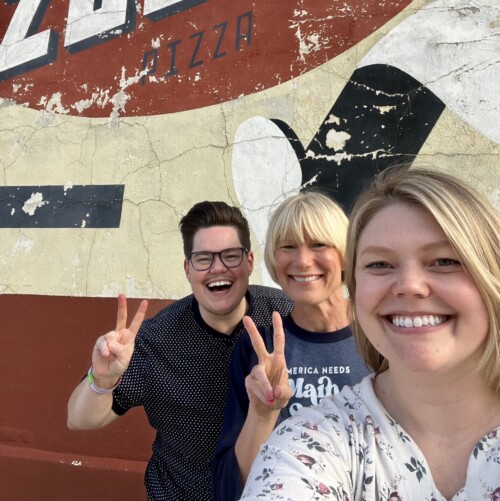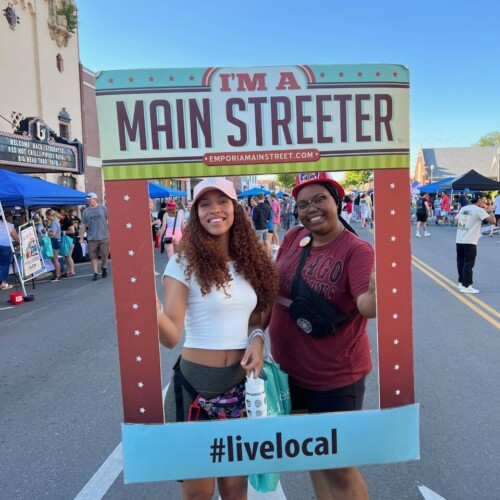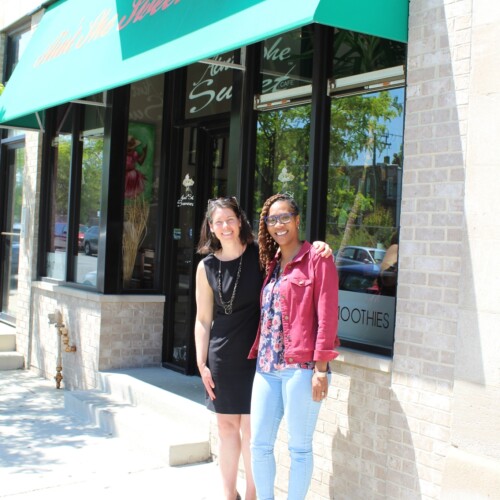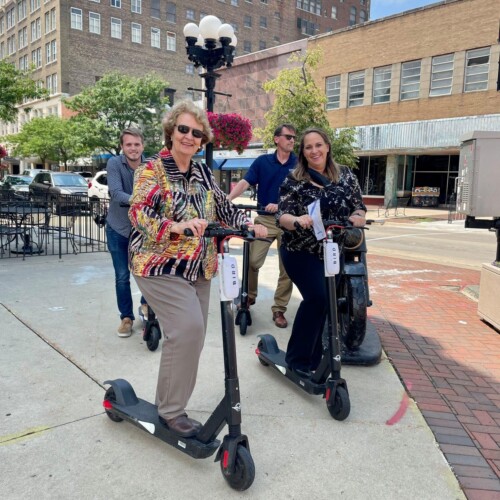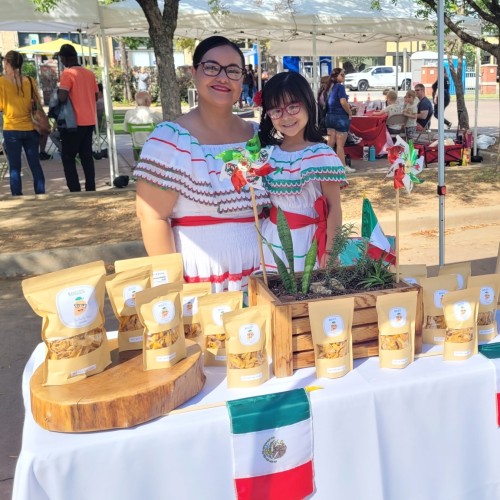July 10, 2019 | Historic Wall Signs Preserve Mooresville’s Past | By Tim Brown, Town of Mooresville Senior Planner | 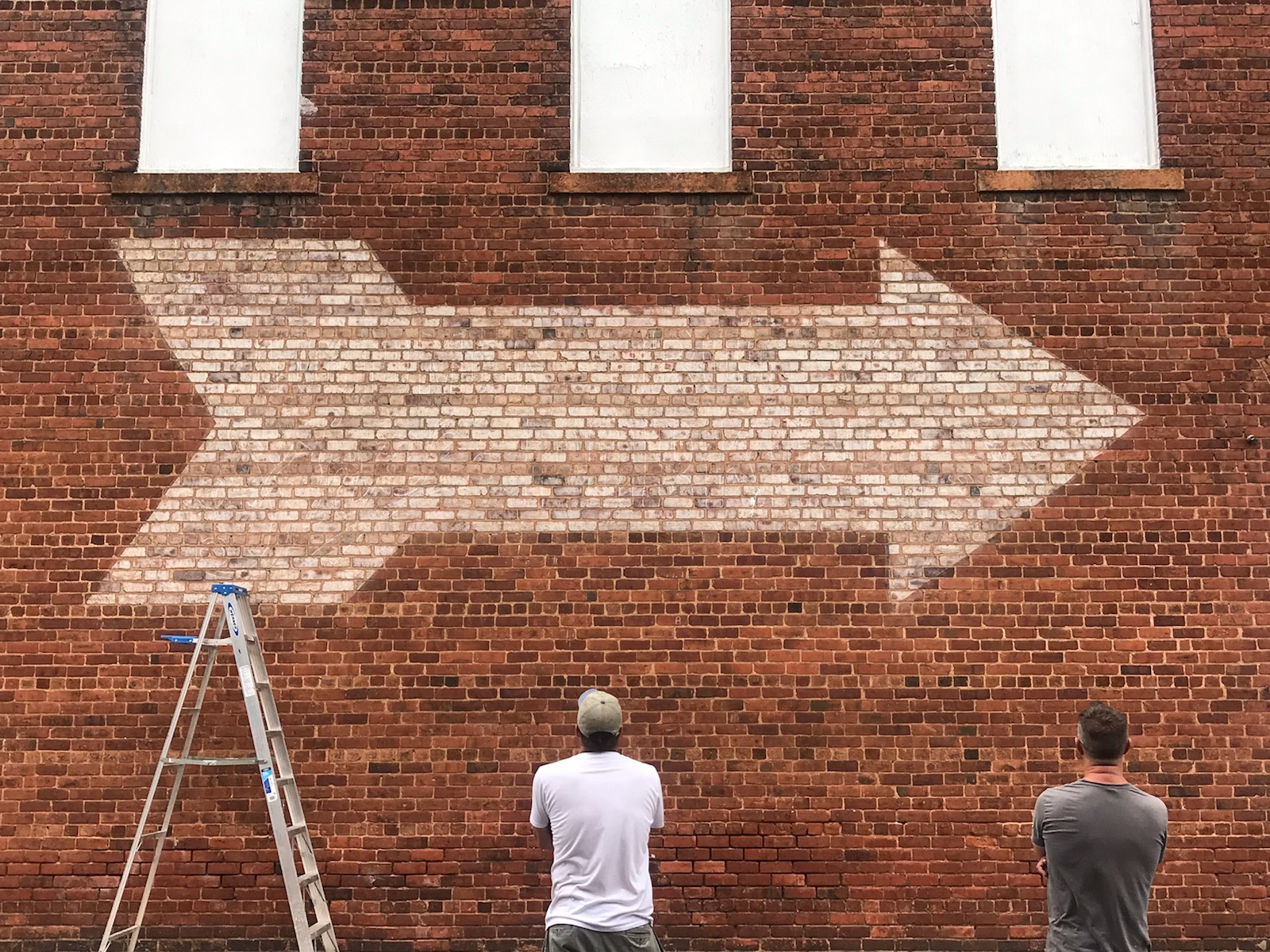
Jeremy Russell and Scott Allred, co-owners of Brushcan Custom Murals, step back and admire their handiwork as they make progress on the Goodman Drug/Free Parking sign off Main Street. Photo credit: Cotton Ketchie
Located about 30 miles north of Charlotte, North Carolina near Lake Norman, Mooresville has grown to a population of more than 40,000 residents, but the town had humble beginnings. In 1856, a local farmer by the name of John Franklin Moore embraced the railroad that was placed on his land, setting up a depot and encouraging other residents to help establish a small village, known as Moore’s Siding. The Civil War put a damper on the developments of Moore’s Siding, however, with the railroads track being removed to aid the Confederate efforts in Virginia and the village’s growth was stifled.
After the war was over and the tracks were returned, Moore’s Siding slowly began to prosper once again, thanks in part to a decision led by John Franklin Moore, who saw the need for the village to incorporate into a town in order to recover from the economic despair of the Reconstruction Era. The town was incorporated as Mooresville in 1873, and the return of the railroad bolstered recovery throughout Mooresville, a pivotal event in 1884 that profoundly shaped the town into a regional trading and textile manufacturing center.
Mr. Moore also helped to establish the first brick making factory in Mooresville, which built some of the first brick buildings on Main Street. Consequently, a commercial district of brick storefronts took shape along Main and Broad Streets, adjacent to the railroad corridor. Rail access ultimately influenced construction of new businesses, such as mercantile shops, restaurants, cotton and linseed oil gins, granaries, a library, a local school system, and the first Town Hall building. Wanting to preserve its rich history, in 1980, historically significant commercial and adjoining residential areas in Mooresville were listed on the National Register. In 2013, the commercial component was locally designated as the Mooresville Commercial Core National Register Historic District.
Today, Mooresville’s historic downtown still embodies the Railroad Era vernacular that typified commercial architecture in small and mid-size communities of the nineteenth and early twentieth century. With the idea of keeping that era alive for residents and visitors alike, the Town of Mooresville recently completed a restoration project worthy of national attention from Main Street advocates and history enthusiasts alike. The project was a joint collaborative effort between the Town’s Historic Preservation Commission and its Beautification Committee, with funding from Mooresville’s Board of Commissioners. Their common goal was to restore painted wall signs that were once commonplace during Mooresville’s Railroad Era heyday.
Several of the downtown buildings that face the railroad tracks along Main and Broad Streets had painted wall signs that advertised historic local business and goods that were previously all within easy walking distance of the Mooresville Depot, much like contemporary billboards. These wall signs contribute to the defining character of Mooresville’s Downtown historic district, transcending their conventional advertising roles of decades ago to become icons. The intrinsic merit of these signs, as well as their contribution to the overall character of the town, made their restoration an important undertaking.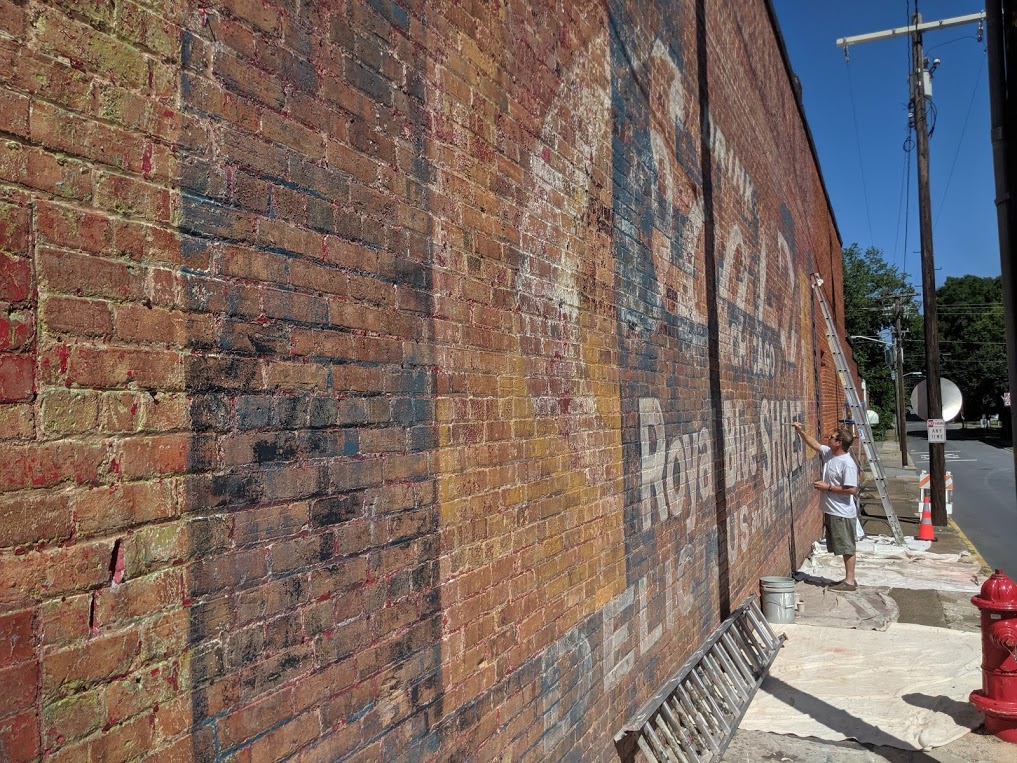
An in-progress shot as Brushcan Custom Murals works to preserve the Coca-Cola and Selz Shoes wall sign on Main Street. Photo credit: Cotton Ketchie
The uptick in historic wall sign restoration can be credited in part to a renewed interest in downtown historic districts. As more communities focus on spotlighting their historic downtowns, wall sign restoration is one means to bring back that sense of nostalgia. Following the appearance of the first Coca-Cola wall sign in Cartersville, Ga., in 1894, the popularity of wall signs as an advertising tool grew dramatically. Wall signs advertised a wide variety of products, goods and services, often flashing distinctive characters and slogans.
As they began to appear in other locales, several Coca-Cola spectaculars, like the one at the corner of Center and Broad Streets, adorned the walls of commercial businesses in Mooresville. Property owners would often rent wall space for painting these advertising signs. As many manufacturers and products gained national and regional prominence, companies such as Selz, Schwab & Company, of Chicago, embraced wall sign advertising particularly to expand brand popularity of its boots and shoes beyond the northern Midwest. Selz remained a major footwear company throughout the 1920s, before falling victim to the crippling Great Depression. Mooresville’s distinctive Selz “Royal Blue Shoes” sign was likely painted over, following the shoe company’s demise, to make way for a Coca-Cola advertisement on the same wall.
An overall view of the restored Kelly Clothing wall sign on Broad Street. Photo credit: Town of Moorseville
Another former sign boasted the local Kelly Clothing Company, which began in 1911, with owner C.L. Kelly, Sr. opening his namesake store at the corner of East Moore Avenue and North Main Street. The store offered name brand men’s clothing, hats and shoes in Downtown Mooresville. In 1953, Kelly’s son, Bubba, took over the store, which then relocated to the 200 block of North Main Street. Bubba operated the store until he retired in 1988, when it was taken over by his longtime protégé, Johnny Smith, who renamed the store John Franklin, Ltd.
Additionally, the Goodman Drug sign’s origins stems from George Caldwell Goodman, who joined a thriving drug store business started by Dr. John McLelland and Dr. Samuel Stevenson in 1877. The store then became known as George C. Goodman & Co. until 1955, when Dr. McLelland passed on in 1905, and it converted to Goodman Drug Co. Mr. Goodman continued to own the business until his death in 1934.
The Town engaged Brushcan Custom Murals, of Asheville, North Carolina, to carefully preserve six severely weathered wall signs, often called “ghost signs.” These signs, including the Seltz Shoes, Coca-Cola, and Mills Department Store wall signs on South Broad Street, as well as the Kelly Clothing Company, Goodman Drugs Free Parking, and Goodman Drugs wall signs, located on North Main Street, had faded over time, to the point where most of the sign image had disappeared.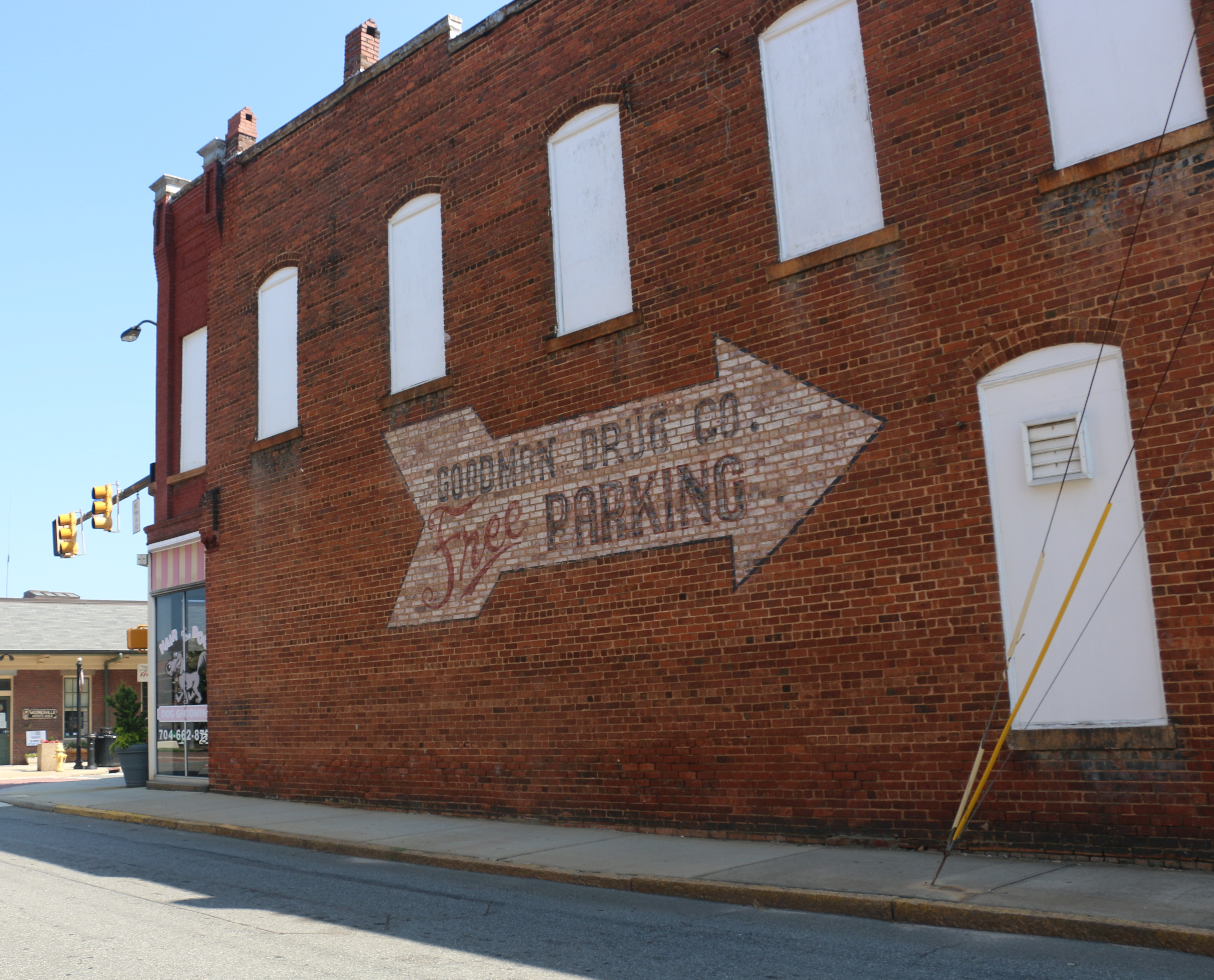
The completed renovation of the Goodman Drug/Free Parking sign. Goodman Drug Co. originally began in 1877. Photo credit: Town of Mooresville
Jeremy Russell and Scott Allred are the co-owners of Brushcan Custom Murals. Russell and Allred might be considered modern-day equivalents of ‘wall dogs, ’the Railroad Era vernacular for sign painters, who plied their trade from town to town in all sorts of weather, perched precariously on scaffolding or suspended from the roof of a building. Together, they bring a combined 45 years of professional experience in fine art, mural, sign, and scenic painting as well as graphic design. Russell and Allred spent a total of 155 hours over 17 days, starting in early June, to carefully restore the wall signs.
Scott Allred explained that typically, a company that distributed on a national level, like Coke or Selz Shoes, which was based out of Chicago, would approach small-town businesses, and offer free signage for that company. In exchange, the companies would then use the rest of that wall for large and colorful advertisements.
“One could even surmise that a mill town was an ideal location for such a sign, due to its localized and saturated audience,” said Allred. “In many ways, this is one of the only forms of two-dimensional public art that we can point to from this time frame.”
He added that although it was not originally meant to be that, looking back, one might observe that it added a certain amount of color and design to the aesthetic of town’s appearance. “From a personal point of view, I find the layered existence of multiple advertisements, spanning many time periods, to be the most beautiful and nostalgic part,” he said. “It’s like peeling back layers of time to reveal the history, and we are very excited to be a part of this.”
Allred described the unique restoration process and techniques that Brushcan has developed to restore these wall signs as a way to “fine tune” the amount of restoration done, so as to capture an appearance that remains “beautifully subtle and faded” and retains their historic design, while still becoming more legible and preserved for the future.
“We start by studying the wall and identifying as much of the original layout as possible,” Allred said. “If there are multiple signs painted on top of each other, we find out which came first, and how the different paint colors helped preserve one another.” It was during this initial step in the restoration process that Russell and Allred discovered the original text of Goodman Drugs parking sign which had faded almost beyond recognition.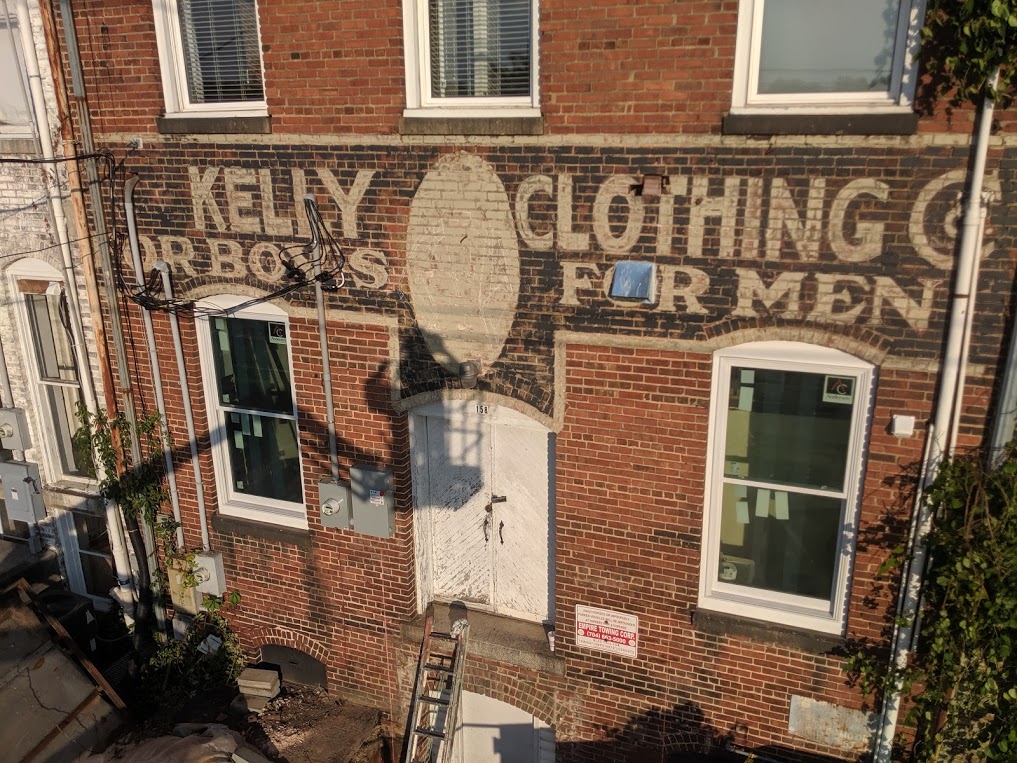
A close-up shot of the completely restored Kelly Clothing wall sign on Broad Street. Kelly Clothing began in Mooresville in 1911, and quickly became a staple for fine men’ clothing. Photo credit: Cotton Ketchie
In order to accurately capture the original appearance of the signs, Allred and Russell generate images of the sign derived from advertisements found in archival local newspapers and phone books. After documenting the original wall sign, the signs are first carefully cleaned, then sealed, with clear acrylic urethane to prevent further weathering of the original paint on the masonry wall.
“At Brushcan Murals, we have a love for historic design…the crossover between old public wall advertisements and murals has made us fond admirers of these ghost signs,” said Allred. “This can be conflicting when asked to restore them, as some of the beauty is in how subtle and faded they are. Painting these signs to look brand new can be a little overpowering and cause them to lose their original charm.”
That’s why the next steps in the process, Allred explains, are a custom mix of paint with exterior professional grade acrylic to match what is on the wall, usually subtle and very muted colors. “The paint is slowly layered and applied in a variety of unconventional techniques, as we always keep in mind how a real exterior sign ages (i.e., how and where the paint typically stays on a wall, decades later, as well as where it doesn't),” he said. “Using multiple layers of very slightly different families of colors, we recreate how paint really ages.”
When the desired level of restoration is achieved, “the sign has the charm of an original, but it’s now preserved,” he said.
The final step is to apply a special varnish to add additional protection from the sun. Brett Sturm, Restoration Specialist with The North Carolina Department of Natural and Cultural Resources, State Historic Preservation office, also provided his perspective on the historic wall sign restoration project.
“From a preservationist’s standpoint, this project shines for the level of thought and sensitivity invested in deciding how the ghost signs could best be conserved,” he said. “Instead of simply repainting them to make them look new again, the conservators stabilized the existing paint layers then artfully overpainted them, blending in new colors to render the faded signs more legible.”
Sturm added that in the case of the Kelly’s Clothing sign, the Town of Mooresville went as far as to consult old local newspaper ads to ensure the restored logo was an accurate match to the original.
“After 155 hours of labor, the result is both nuanced and beautiful—signs that show their age, telling the story of Mooresville’s historic downtown,” he said. “To restoration-minded folks like us here at the State Historic Preservation Office, perhaps the best part is that the signs are protected for the future, sealed with a UV-inhibiting varnish so that they can continue to communicate with Mooresville locals and visitors for decades to come.”
Downtown Mooresville now has a total of nine historic wall signs that have been restored, and plans for future restorations are being considered.
About the author:
Tim Brown is a landscape architect and a Senior Planner who has been with the Town of Mooresville since 2001. He currently serves as staff liaison for the Mooresville Historic Preservation Commission. Mr. Brown’s 30 years of professional experience in public sector planning has been located in some of the fastest growing communities in North Carolina, and among the most desirable communities to live in the Southeast.
